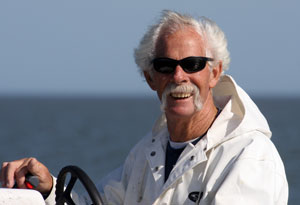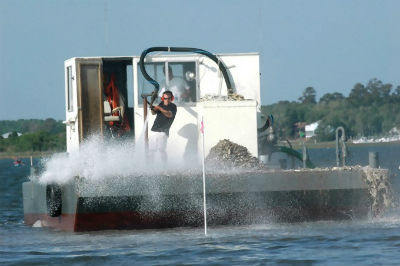OCRACOKE — Ocracoke Island is surrounded by historic, shallow-water oyster beds, which have provided the island with protection from waves during storms and delicious seafood for islanders and visitors.
In recent years, however, oyster reefs have suffered a dramatic decline, reducing them to a fraction of their former expanse. This decline has been occurring all along the coast, but Ocracoke’s losses have been especially alarming. “The oysters thrive for a short while” says James Barrie Gaskill, a commercial fisherman on the island and a board member with the N.C. Coastal Federation, “but they are dead before their fourth year.”
Supporter Spotlight
A collaborative effort by state officials, environmental groups and local fishermen is underway to understand and reverse the losses. Currently, the N.C. Division of Marine Fisheries is working with Ocracoke watermen on a new approach to restoring healthy oysters in the area.
 James Barrie Gaskill is among the Ocracoke commercial fishermen who will help the state create oyster reefs. |
Their efforts began with a meeting in early January at the Ocracoke Waterfront Museum, where state biologist Clay Caroon listened to fishermen from the Ocracoke Working Watermen’s Association share their opinions and suggestions about the best sites for new reefs. The fishermen mapped out sites that they thought would work, and the NCDMF took the information with them. The fishermen told Caroon that they would help create oyster reefs in productive and workable areas near Ocracoke.
Oyster reefs are valuable marine habitat. They filter and clean the water as they feed, and provide important habitat for many marine species. Common oysters, a species of marine mollusk known to scientists as Crassostrea virginica, are free-floating in their larval stage, but once they attach to a bottom they develop into small oysters called spat and stay put. They often attach to one another and form huge congregates known as oyster reefs.
The state has been creating oyster reefs up and down the coast, and it currently has 10 oyster sanctuaries in Pamlico Sound, where no harvesting is allowed. Barges lay out oyster shell or marks, called cultch, which attract oyster larvae to attach and eventually develop as oysters. According to Caroon, the division’s long-term oyster sanctuaries that are in high salinity areas like Ocracoke do well for the first few years. After three or four years, however, they begin to fail, and the oysters die. It is believed that predation by crabs, boring sponges, oyster drills, and fish, particularly sheepshead, are mainly responsible. The recent failure of the state’s Ocracoke Oyster Sanctuary, near the Le-High shipwreck, is attributed primarily to infestation by boring sponges and oyster drills, which thrive in high salinity.
The division also seeds oysters for public use. They have conducted such projects in the Ocracoke area since the 1980s, the last being in 2010. These cultch planting sites, different from the sanctuaries, produce fast-growing oysters which can be harvested in 18 to 24 months.
Supporter Spotlight
“This Cultch Planting Program,” said Caroon, “is funded specifically for public harvest. The ecosystem enhancement is an added benefit.”
To make the program successful, “we rely on fishermen and the public,” Caroom said.
What makes this approach different is the decision to seed the cultch in many small areas of sand and to scatter the shells and marl very thinly, in hopes of reducing infestation by boring sponges and oyster drills. Large, high-density beds seem to lead to more die-offs. , so what they want is lots of sites without such high density. With multiple sites the watermen can then have more places to work. The oysters should be harvested in about two years, before they die.
 The state uses barges to distribute oyster shells and marl to create reefs. |
One of the considerations in planting the cultch is the presence of submerged aquatic plants such as eelgrass and shoal grass. Eelgrass, often referred to locally as seaweed, is an important component of the sound’s ecosystem, providing habitat and food for marine species such as crabs, shrimp and finfish. The oyster beds are supposed to avoid grass beds, but some of the best oyster beds have, according to local watermen, been in or near grass beds. The sites they are looking for are sandy bottoms with grass growing around them.
Many of these are in shallow waters which previously could not be reached by barges, but NCDMF now has a shallow-draft barge which makes them accessible. Once the sites are harvested and cleared of shells, Caroon said, they could be replanted, if deemed productive.
David Hilton, an Ocracoke fisherman and a former member of the Marine Fisheries Commission, is president of the Ocracoke Seafood Company. He is excited about the agreement. He said that after working for several years to get a permit for seeding oysters, the watermen’s association finally succeeded last summer. The association now has an oyster bed behind the island, east of Oyster Creek, where fishermen planted two to three truckloads of cultch last summer.
Ocracoke waterman Gene Ballance, who has been mapping old oyster beds in Pamlico Sound for about 10 years, is also optimistic. He says he has been seeding oysters for years, but with limited success. He more recently began working with the N.C. Coastal Federation, the Audubon Society and the N.C. Land Trust to restore oyster reefs as protection against storm destruction, in areas off Springer’s Point and on Beacon Island.
This spring Iky Oneal, Stevie Wilson, Ballance and other local fishermen will head out into the Pamlico Sound in their skiffs, working with the state to search for small shallow areas with sandy bottoms that appear to be good oyster territory. Using GPS location devices, they will record the sites, and state will mark them with PVC pipes. When the water temperature reaches about 70 degrees, ideal for setting spat sometime between April and June, state biologists will return to Ocracoke. Using a newly purchased shallow-draft large, they will distribute oyster-shell cultch in the designated sites, in hopes that oyster larvae will attach to the shells and grow into harvestable oysters.
Ocracoke fishermen and Marine Fisheries officials alike are hopeful that this time their efforts will succeed, and Ocracoke’s historic shallow-water oyster beds will once again provide winter-time jobs for local fishermen, as well as cleaner water and marine life habitat.








